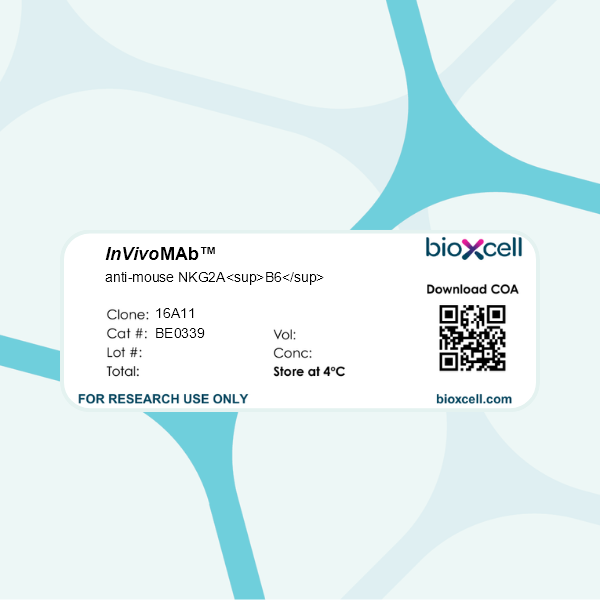InVivoMAb anti-mouse NKG2AB6
Product Description
Specifications
| Isotype | Mouse IgG2b, κ |
|---|---|
| Recommended Isotype Control(s) | InVivoMAb mouse IgG2b isotype control, unknown specificity |
| Recommended Dilution Buffer | InVivoPure pH 7.0 Dilution Buffer |
| Conjugation | This product is unconjugated. Conjugation is available via our Antibody Conjugation Services. |
| Immunogen | C57BL/6 mouse CD94/NKG2A transfected CHO cells |
| Reported Applications | Flow cytometry |
| Formulation |
PBS, pH 7.0 Contains no stabilizers or preservatives |
| Endotoxin |
≤1EU/mg (≤0.001EU/μg) Determined by LAL assay |
| Purity |
≥95% Determined by SDS-PAGE |
| Sterility | 0.2 µm filtration |
| Production | Purified from cell culture supernatant in an animal-free facility |
| Purification | Protein A |
| RRID | AB_2894759 |
| Molecular Weight | 150 kDa |
| Storage | The antibody solution should be stored at the stock concentration at 4°C. Do not freeze. |
| Need a Custom Formulation? | See All Antibody Customization Options |
Application References
Flow Cytometry
Vance, R. E., et al. (2002). "Implications of CD94 deficiency and monoallelic NKG2A expression for natural killer cell development and repertoire formation" Proceedings of the National Academy of Sciences 99(2): 868-873.
PubMed
Natural killer (NK) cells are believed to achieve self-tolerance through the expression of self-MHC-specific inhibitory receptors, such as members of the Ly49 and CD94/NKG2 families. Individual Ly49 genes are stochastically expressed by NK subsets and are expressed in a monoallelic fashion, but little is known about the mechanisms underlying CD94/NKG2A expression. We show here that, like Ly49 genes, mouse Nkg2a is stochastically and monoallelically expressed. Thus, a single general mechanism controls expression of all known MHC-specific receptors by mouse NK cells. In addition, we find that DBA/2J mice are naturally CD94-deficient and do not express cell-surface CD94/NKG2A receptors, even on neonatal NK cells. Thus, self-tolerance of neonatal NK cells cannot be attributed to CD94/NKG2A expression. Taken together, the results lead to a reconsideration of current models of NK cell development and self-tolerance.
Product Citations
-
-
Cancer Research
-
Immunology and Microbiology
Bimodal Effect of NKG2A Blockade on Intratumoral and Systemic CD8 T Cell Response Induced by Cancer Vaccine.
In Cancers (Basel) on 27 May 2024 by Riva, E., Carboni, S., et al.
PubMed
Immune check-point blockade (ICB) has revitalized cancer immunotherapy, showing unprecedented efficacy despite only a narrow number of indications and with limited long-term protection. Cancer vaccines are promising combination partners for ICB to widen the patient population profiting from these treatments. Therapeutic heterologous prime-boost vaccination with KISIMATM protein vaccine and VSV-GP-TAg oncolytic virus was shown to inflame the tumor microenvironment, promoting significant infiltration of antigen-specific CD8 T cells resulting in robust antitumoral efficacy in mouse tumor models, and clinical trials are currently ongoing. Here, we report the impact of NKG2A blockade on antitumoral CD8 T cell immune response elicited by KISIMA-VSV-GP-TAg vaccination in tumor mouse models. Combination therapy significantly reduced the amount of vaccine-induced exhausted CD8 T cells infiltrating the tumor, resulting in short-term improved tumor growth control and prolonged mouse survival, while it also influenced the establishment of systemic effector memory CD8 T cell response. Taken together, these data show a compartment-dependent effect of NKG2A blockade on cancer vaccine-induced T cell immunity, increasing intratumoral T cell efficacy and attenuating the development of peripheral effector memory CD8 T cell response.
-

